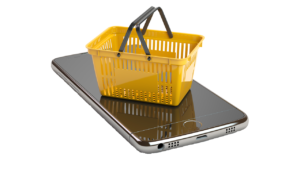According the Supermarket News staff, “The grocery industry has witnessed more change in the past two years than perhaps the entire previous decade.”[1] And, they add, “There’s no rest for the weary. As we head into the new year, it’s inevitable that there is more evolution to come.” Grocery Dive journalists agree with that assessment. They write, “Retailers are heading into a 2022 filled with challenges. The supply chain shortage continues to batter shelves, and record-high inflation doesn’t seem like it will resolve any time soon, forcing companies to raise prices and potentially frustrate their customers.”[2] Consumers are, in fact, feeling the pinch. Grocery industry journalist Sam Silverstein (@SilversteinSam) reports, “Shoppers expect to spend an average of $611 per month on groceries [in 2022], an increase of about $79, or nearly 15%, over their projected food budgets for 2021, according to a consumer survey conducted by accounting firm KPMG.”[3] Below are more of the trends experts predict will affect the grocery sector this coming year.
Grocery Sector Trends
More Hybrid Grocery Shopping. Alicia Enciso, chief marketing officer of Nestlé USA, writes, “In the past, consumers would either buy their groceries online or in-store. That behavior has changed, and many consumers are now buying from both, recognizing the unique benefits of each option. Spending more time at home has changed the landscape of e-commerce, and our research indicates that many shoppers will not return to pre-COVID behaviors — as many as 85% say they will continue to use online shopping a year from now.”[4] Online grocery shopping will also get a boost as the U.S. Government’s Supplemental Nutrition Assistance Program (SNAP) goes online. Food reporter Catherine Douglas Moran (@c_douglasmoran) explains, “Amazon and Walmart have dominated the space, but that will soon change with hundreds of grocers in the pipeline to join the federal government’s SNAP Online Purchasing Pilot.”[5] The Supermarket News staff predicts, “Online will represent more than 15% of grocery retail sales in 2022, up from around 10% at the end 2021.”
Private Labels Gain Ground. Gary Stibel (@NECG_GaryStibel), founder and CEO of New England Consulting Group, predicts private label and value brands, after losing ground during the pandemic, will make a comeback in 2022.”[6] The primary driver of this growth will be inflation as consumers look for values in order to stretch tight food budgets.
More Ways to Skip the Checkout Line. The Supermarket News staff predicts, “Shoppers will expect skipping the checkout line — via frictionless payment solutions like scan-and-go, smart shopping carts and technologies like Amazon’s Just Walk Out — to become a daily option at large chain grocery stores.”
Quick Delivery Expands. An obvious way consumers can skip the checkout line is to have someone else do the shopping and have their groceries delivered. The Grocery Dive staff write, “Following the ultrafast delivery boom in New York City and the rollout of faster service from e-commerce platforms like DoorDash and Instacart in 2021, this year will see widespread adoption of faster operations among top retailers, especially as they look to court younger shoppers, experts said.” There is a caveat. If inflation continues to rise, consumers could balk at paying extra to have groceries delivered. Price generally trumps convenience during hard times. The Supermarket News staff predicts the number of quick delivery service companies will decline. They explain, “The plethora of online-only grocers offering ultra-fast delivery (10 to 15 minutes) will thin out in the latter part of 2022 as major brick-and-mortar grocers expand their rapid delivery services and build out omnichannel ecosystems in major metro markets.”
Significant Labor Shortages. This past November a record number of workers (4.5 million) walked off the job — most whom worked in low wage positions. Grocery Dive journalists report, “Grocers are struggling to keep their stores and warehouses staffed in what many fear is a foundational readjustment in the labor market.” As a result, they predict, many stores will turn to automation to augment their workforce. They explain, “Many companies need immediate solutions to handle the heavy flow of in-store and digital business. Gautham Vadakkepatt, director of the Center for Retail Transformation at George Mason University, predicted that retailers will hasten their adoption of automation technology to manage tasks not only in the backroom and warehouses but also in customer-facing areas of stores.” Nicole DeHoratius, a professor of operations management at the University of Chicago Booth School of Business, told Grocery Dive that, “given the continuing difficulty it’s facing in hiring enough workers, the grocery industry needs to combat the perception that retail jobs are not bona fide career opportunities.”
Better Use of Data. Grocery Dive reporters note, “As the grocery business increasingly migrates online, retailers are seeing a growing need to use the data they collect through their digital channels to improve their ability to satisfy customers who have grown accustomed to personalized shopping experiences.” Both CPG manufacturers and retailers can benefit from this data. Cognitive solutions, like the Enterra Shopper Marketing and Consumer Insights Intelligence System™, the Enterra Trade Promotion Optimization System™, and the Enterra Global Insights and Decision Superiority System™, can help manufacturers and retails understand and adapt to the changing consumer landscape.
New Store Models. Moran reports a number of grocery chains are looking at smaller-format stores for select markets. She notes, “Going smaller is driven by size constraints, whether it’s setting up shop at existing sites in rural communities or downsizing to fit into urban environments.”[7] The Supermarket News staff predicts the grocery sector will see other new store models as well. Rather than going small, some stores will go big. They explain, “Big grocers will increasingly add popular retail and consumer brands — in such categories as apparel/accessories, electronics, home/office supplies, housewares, health/fitness, beauty and baby care — via digital marketplaces and store-with-a-store departments.” They also expect to see other new innovations. They write, “The first omnichannel grocery store prototypes — incorporating features like automated picking areas, expanded perimeter and reduced center-store spaces, customer pickup counters, self-serve order collection, ordering kiosks and more drive-up options — will debut in major markets.”
In-store Meal Preparation. When the pandemic lockdowns were put in place, grocers put the lid on their in-store cafes and buffets. However, journalist Jeff Wells (@JeffWellsWH) reports, “After the coronavirus shuttered in-store restaurants and bars built to add the wow factor to their stores, grocers are eager to fully return to form. Rather than shying away from offering fresh meals and in-store dining due to lingering safety concerns, elevated at-home cooking trends and other factors, grocers are leaning into restaurants like never before.”[8] The Supermarket News staff adds, “As grocers gain ‘share of stomach’ from restaurants, supermarkets will see big growth in prepared meal services, both in-store and online ‘order ahead’ offerings.”
Concluding Thoughts
Patrick Spear, President & CEO of GMDC | Retail Tomorrow, believes grocers, like many other employers, will have to be creative in order to attract and retain employees in today’s job market.[9] And, like the Grocery Dive staff, he believes grocers will need to make better use of their data. He suggests they employ consumer journey mapping. He explains, “With journey mapping, companies can create customer personas, such as the omni-choice shopper we’ve become accustomed to, that allows them to gauge the consumers’ thought process behind the buying behavior, if their values align with the product that they’re interested in purchasing or if the company holds similar values to them. By linking each interaction with the customer, from online search to browsing a product in-store, retailers can ensure each experience is a perfect fit.” Finally, Spear believes grocers will have to engage in creative partnerships to enhance their business model. He concludes, “It’s safe to say that these three key trends will pick up strong momentum in the upcoming year with many retailers and grocers continuing to find ways to keep up with the omni-choice shopper who demands a ‘phygital’, personalized shopping experience. Through creativity, intention, flexibility and the desire to always adapt with the times, retailers can remain on the forefront of innovation.”
Footnotes
[1] Staff, “10 predictions for the grocery industry in 2022,” Supermarket News, 17 December 2021.
[2] Jeff Wells, Catherine Douglas Moran, and Sam Silverstein, “7 trends that will shape the grocery industry in 2022,” Grocery Dive, 4 January 2022.
[3] Sam Silverstein, “Grocery budgets set to climb nearly 15% in 2022,” Grocery Dive, 17 December 2021.
[4] Alicia Enciso, “Food 2022: Nestlé USA’s Predictions for the Next Big Thing in Food,” Medium, 6 December 2021.
[5] Catherine Douglas Moran, “Exploring the rise of SNAP online,” Grocery Dive, 19 February 2021.
[6] Chris Casey, Christopher Doering, and Megan Poinski, “6 trends shaping food and beverage growth in 2022,” Food Dive, 4 January 2022.
[7] Catherine Douglas Moran, “5 grocers planning smaller formats,” Grocery Dive, 18 August 2021.
[8] Jeff Wells, “Food halls, ghost kitchens and the future of in-store restaurants,” Grocery Dive, 24 March 2021.
[9] Patrick Spear, “How retailers can evolve and thrive in 2022,” Supermarket News, 23 November 2021.





